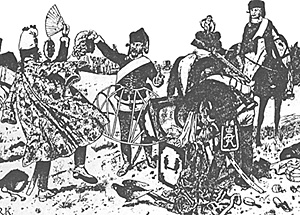 Prussian operations in Moravia were entering their critical final phase by June 28, 1758. Field Marshal Kieth's siege corps stood poised to take the fortress of Olmutz, the army's primary objective, thus clearing the way for further thrusts into enemy territory. Keith's forward positions were now entrenched on the fortress' glacis and the wall in front of them had been reduced to rubble within the past two days from the constant pounding of 116 heavy guns. The Austrian artillery had been silenced and it appeared that the fortress of Olmutz would be lost.
Prussian operations in Moravia were entering their critical final phase by June 28, 1758. Field Marshal Kieth's siege corps stood poised to take the fortress of Olmutz, the army's primary objective, thus clearing the way for further thrusts into enemy territory. Keith's forward positions were now entrenched on the fortress' glacis and the wall in front of them had been reduced to rubble within the past two days from the constant pounding of 116 heavy guns. The Austrian artillery had been silenced and it appeared that the fortress of Olmutz would be lost.
However, operations were seriously behind schedule. Frederick of Prussia had hoped that Keith's men would be on the glacis by June 17 and in possession of Olmutz by the 22nd, but they had been constantly hampered by a shortage of ammunition as well as by Frederick's own meddling in the direction of the siege works. [1].
With a siege corps of less than 11,000 men and a covering force of only 30,000 , the Prussian siege effort was severely overstretched [2].
Food and ammunition were growing short and morale was so low that men actually deserted into the besieged fortress.
The condition of the commanders was scarcely better. Frederick was in poor health and in one of his infamous depressions, while Marshal Keith was wracked by fever and asthma and Fouque had been laid low for several days by a spent cannister ball. The local population was openly hostile, concealed information from the Prussian invaders, and assisted the Austrians. Vicious reprisals can scarcely have helped the Prussian cause, while Mitchell, the British representative with the army, noted 'in this army the spies are paid too sparingly, consequently the intelligence is none of the best, and when there comes intelligence, which does not agree with the hypothesis we have formed, that intelligence is little regarded.' [3].
Enemy relief forces were known to be approaching, though their size and position was uncertain. Whether Keith's men could take Olmutz before the relief forces appeared depended on the arrival of a huge convoy from Silesia bringing vital supplies and reinforcements.
The supply situation had been a constant problem since the start of the operation. Including Fouque and Zieten's corps protecting the Silesian frontier, Prussian forces totalled 55,000 men, including at least 13,500 cavalry. There were an additional 32,000 transport horses for the regimental and army baggage wagons, plus 14,000 more for the 294 cannon and mortars, and 40 pontoons. The bulk of these men and animals had been confined to an area within a 10 mile radius of Olmutz since May 6, 1758.
Swarms of Austrian irregulars infested the surronding hilly, wooded countryside preventing the Prussians from foraging further afield. All additional supplies, as well as all ammunition, had to come from the Prussian magazine at Niesse, over 90 miles away. The first half of this route lay in the area protected by Fouque and Zieten. However, the last 45 miles from Troppau to Olmutz ran over narrow, twisting mountain roads, past gloomy Moravian villages and dark spruce forests, providing ideal cover for surprise attacks.
Three convoys had made this difficult journey so far. The first, with 800 wagons and the entire siege train, arrived safely on May 20, about two weeks after Frederick had reached Olmutz. Its comparatively easy passage seems to have misled him into underestimating the difficulty of maintaining his communications with Neisse. The second convoy's experience revealed the true danger. Although General Puttkamer arrived safely on June 1 with 3,000 recruits and large quantities of gunpowder and flour, the escort of two free korps battalions was ambushed on its return journey on the 8th and virtually destroyed. A third convoy of 1,000 wagons and 7,000 recruits and reconvalescents arrived two days later without incident, to the amazement of the Prussian officers. However, this only provided some temporary relief, for by June 18th, Keith's artillery only had ten day's ammunition supply left. All now depended on the fourth vital convoy of nearly 4,000 wagons which was expected to reach Olmutz on June 28th.
The Ambush of the Olmutz Convoy At Domstadtl June 28-30, 1758
- Introduction
The Olmutz Convoy
Rounds 1 and 2
Commentary, Footnotes, Bibliography
Orders of Battle: Prussian and Austrian
Jumbo Campaign Map (very slow: 237K)
Large Convoy Map (slow: 76K)
Back to Seven Years War Asso. Journal Vol. VIII No. 4 Table of Contents
Back to Seven Years War Asso. Journal List of Issues
Back to Master Magazine List
© Copyright 1996 by James E. Purky
This article appears in MagWeb.com (Magazine Web) on the Internet World Wide Web.
Other articles from military history and related magazines are available at http://www.magweb.com